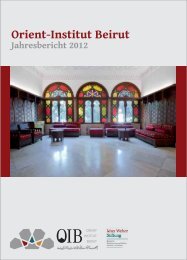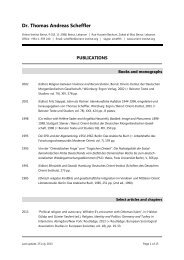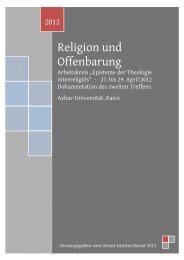Orient-Institut Beirut
Orient-Institut Beirut
Orient-Institut Beirut
Sie wollen auch ein ePaper? Erhöhen Sie die Reichweite Ihrer Titel.
YUMPU macht aus Druck-PDFs automatisch weboptimierte ePaper, die Google liebt.
<strong>Beirut</strong>, LAU, 13. 3. 2008, Symposium, Popular Memory and the Formation of Identities<br />
(Lebanon as a case study): “Religious identity, ethnicity, gender: negotiating difference in<br />
pre-modern popular literature (Sirat Hamza, 19th century)”.<br />
Kiel, 3. 4. 08. Konferenz, Notes on Manuscripts as a Source in Islamic Studies: State of the<br />
Art and Future Research Perspectives: “The Policies of Piety. Understanding the Text<br />
through its Transmission”.<br />
Istanbul, 9. 4. 08, <strong>Orient</strong>-<strong>Institut</strong>: “The Policies of Piety. Understanding the Text through its<br />
Transmission” (gleicher Titel, anderer Inhalt).<br />
Alexandria, 7.5.08: Conference “Imbedded Texts”: Manuscripts and the concepts of<br />
scripturality: The role of warrāqūn and ruwāt in the production of manuscripts<br />
Istanbul, 6.9.08 Kashgari Konferenz: Kashgari’s approach to lexicography: application and<br />
modification of the Arabic model<br />
<strong>Beirut</strong>, 24.10. 08., Gemeinsames <strong>Institut</strong>skolloquium: „Eine neue Lesart zur politischen<br />
Dimension sunnitischer Frömmigkeitslehre (9.-13. Jahrhundert)“.<br />
Damaskus, IFPO 12.11. 08: « Comprendre un texte par sa transmission : La dimension<br />
politique de la piété relue (9 ième - 12 ième siècle) »<br />
Tripolis, 16.11.08, Konferenz: “<strong>Institut</strong>ional teaching and scholarship in late Mamluk and<br />
early Ottoman period: Raptures and continuities.”<br />
<strong>Beirut</strong>, 12.12. USJ, Centre Louis Pouzet: « Le jihad en réponse du model chrétienne ?<br />
Concepts et représentation Ayyubides. »<br />
D Veröffentlichungen<br />
a) Erschienen sind im Berichtszeitraum:<br />
„Der Kaiser als Freund der Muslime.“ In: Friedrich II. von Hohenstaufen. – Die Welt des Sultans<br />
von Lucera. Mainz (Zabern) 2008, S. 66-77.<br />
„Beduinentum, Araber, Nomadenmythos in der Montage von Ibn Khaldun.“ In: Alexander<br />
Weiß (Hg.): Der imaginierte Nomade. Formel und Realitätsbezug bei antiken, mittelalterlichen und<br />
arabischen Autoren. Reichert 2008, S. 69 – 101.<br />
„Speculum principum“, <strong>Orient</strong>. In: Enzyklopädie des Märchens. 2008.<br />
„Mit eigenen Augen. Zur Empirie in al-Azhar:is (4./10. Jh.) Wörterbuch“. In. HBO 42 (2005),<br />
215-222 [erschienen 2008]<br />
b) Abgeschlossen:<br />
„Spott im Ornat. Humor auf zweiter Stufe bei Ibn Arabschah (st.1450)“, in George Tamer<br />
(Hg.): Humor in der arabischen Kultur.<br />
“Myths of Nomads and Their Use: Two Cases in Transcultural Perspective”, zusammen mit<br />
Alexander Weiß.<br />
“Heroes, friends, enemies: The dynamics of Muslim identity in representations of Saladin<br />
and Frederic II.” Konferenzband <strong>Beirut</strong> / Istanbul.<br />
23







